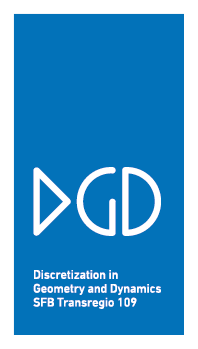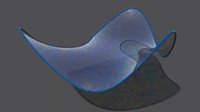Koebe Polyhedra
Stefan SechelmannMedia
Description
We present a couple of Koebe polyhedra. A Koebe polyhedron is a polyhedron with its edges tangent to the unit sphere. Koebe polyhedra have a strong connection to the theory of circle patterns, see [1]. The theory of discrete minimal surfaces of s-isothermic and s-conical type is based on Koebe polyhedra, see [2].
The first step for the construction of a Koebe polyhedron is to create an orthogonal circle pattern corresponding to the desired polytopal cell decomposition of the sphere. This is generally done by finding critical points of the following spherical functional (for full details see [BHeS2006]) expressed in the the variables $\rho_i = \log\tan\frac{r_i}{2}$ given by the spherical radii $r_i$: \begin{align} S(\rho) = \sum_{(j,k)}\left( \mathrm{Im}\mathrm{Li}_2(ie^{\rho_k-\rho_j}) + \mathrm{Im}\mathrm{Li}_2(ie^{\rho_j-\rho_k}) - \mathrm{Im}\mathrm{Li}_2(ie^{\rho_j+\rho_k}) -\mathrm{Im}\mathrm{Li}_2(ie^{-\rho_j-\rho_k}) \right.\\ \left. - \pi(\rho_j+\rho_j) \right) + \sum_j \Phi_j\rho_j. \end{align} Here, the first sum is taken over all pairs $(j,k)$ of neighboring circles and the second one runs over all circles $j$. The dilogarithm function $\mathrm{Li}_2(z)$ is defined by \[\mathrm{Li}_2(z)=-\int_0^z \frac{\log(1-\zeta)}{\zeta}\,d\zeta.\] For each circle $j$, $\Phi_j$ gives the angle that is covered by its neighboring circles. It is normally $2\pi$ for interior circles, but it differs for circles on the boundary and for circles where the pattern branches. In many cases (in particular in case of unbranched cellular decompositions of the sphere) the circle radii can be obtained by minimizing the analogous euclidean functional that is known to be convex.
Once the radii are known the circles can be layed out. The still remaining freedom of applying a Moebius transformation can be fixed (up to a simple rotation) by requiring the center of mass to be at the sphere center.
The vertices of the circumscribed Koebe polyhedron that corresponds to the circle pattern can now be easily found by inverting the euclidean centers of the circles at the $\mathbb S^2$ (the cone tips are the polar points to the planes containing the circles). Here we have the freedom to choose one family of circles to become vertices of the Koebe polyhedron and the other family to become faces, see Images [Circle Pattern and Koebe Polyhedron 1] and [Circle Pattern and Koebe Polyhedron 2] for a visualization of both choices.
References
-
Alexander I. Bobenko and Boris A. Springborn.
Variational principles for circle patterns and Köbe’s theorem.
Trans. Amer. Math. Soc, 2004(356):659–689, 2004.
-
A. Bobenko, T. Hoffmann, and B. Springborn.
Minimal surfaces from circle patterns: Geometry from combinatorics.
Ann. of Math., 164(1):231–264, 2006.
arXiv:0305184.











